The cervix is the opening to the uterus. It connects the vagina (birth canal) with the uterus. When cancer starts in the cervix, it is called cervical cancer.
Most cervical cancer causes no symptoms when it is small. When the cancer is large, it can cause symptoms such as pain and bleeding.
Pap tests are done to find cervical cancer early. A Pap test looks for abnormal cells on the cervix. This can be done by a nurse, doctor, or midwife.
Human Papillomavirus (HPV)
Some types of cervical cancer are caused by a virus called human papillomavirus (HPV). HPV is a common sexually transmitted infection (STI). This means it is a germ that is passed between people during sexual activity. Many people are infected with HPV at some time in their lives and it causes no problems. Sometimes the body can get rid of the virus but sometimes it stays. For some people, HPV can cause cervical cancer.
There is a vaccine available that protects against some types of HPV that can lead to cervical cancer. It also protects against genital warts. Boys and girls over 9 years old can get this vaccine in Nunavut. The vaccine (called Gardasil vaccine) is available for free to all grade six students.
How to reduce your risk of cervical cancer:
- Consider getting the HPV vaccine. The vaccine is available for free to all grade six students.
- Reduce or stop smoking. For help, talk to a health care provider, visit nuquits.ca, or call the Nunavut Quitline at 1-866-368-7848.
- Practice safer sex. If you are having sex, use condoms to reduce the risk of getting HPV and other STIs. Talk to your partner(s) about their sexual history.
- If you are a woman aged 21-69, get screened with a Pap test. It is recommended that women aged 21-69 have a Pap test every 3 years. A Pap test is different from STI tests but can usually be done at the same time as these tests. Talk to your health care provider about the tests they recommend for you.
For more information about cervical cancer, talk to a health care provider or visit the Cervical Cancer page on the Public Health Agency of Canada.



